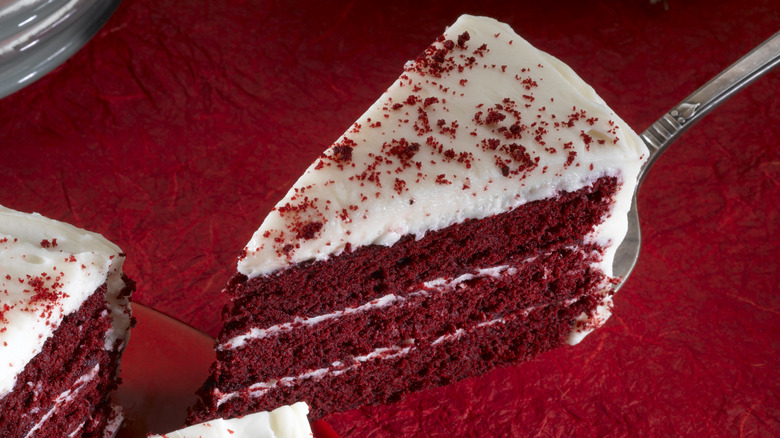The Best Type Of Food Coloring To Use For Vibrant Red Velvet Treats
What makes a red velvet cake, a red velvet cake? It's not just the buttery sponge cake or the ermine icing. Instead, it's that beautiful crimson-red color you see when you slice into it. Without that distinctive red hue, it wouldn't count as a red velvet cake, would it? To get this lovely color, you'll need to use food coloring, and there are plenty of options for you to pick from.
For this recipe, your best choices are either concentrated gel or liquid food colorings. Concentrated gel food colorings (sometimes called "gel paste dye" or "icing color") stand out for their intensity. These colors come in small pots, have a thick, gel-like consistency, and are super concentrated. Just a tiny dab on the tip of a toothpick is all you need to get a rich, bold red color. This intense concentration is especially handy for recipes like red velvet cake, where you want a super bright color.
Your second choice is liquid colorings. They're the weakest of all food colors, so you'll have to use a lot more to get the same vibrancy as the gel. On the plus side, they come in convenient squeeze bottles and have a water-based formula, which makes them easier to mix into batters compared to the thicker gel colors. They're also cheaper and more accessible, making them a practical choice for home bakers. Just be sure to buy high-quality, bake-stable coloring that won't easily fade after baking.
Is it possible to make red velvet treats without food coloring?
Absolutely! Red velvet treats have a rich history dating back to the 19th century when artificial food colorings were not commonly used. Despite this, people from that era still managed to achieve a deep red color using entirely natural ingredients. You only need three simple ingredients: natural, non-Dutch cocoa powder, vinegar, and buttermilk.
Unprocessed cocoa powder is highly acidic and bitter, which makes it very hard to eat. To make it more palatable, modern cocoa powders undergo a process called "Dutch processing," where they are treated with an alkalizing agent to take away the harsh acidity. However, for red velvet treats, you want to use natural, non-Dutch cocoa powder, which has a unique property. When mixed with an acid like vinegared buttermilk, this cocoa powder turns red!
This color-changing reaction happens because cocoa powder contains a natural pigment called anthocyanin. The interaction between the acid and cocoa activates this pigment, giving the cocoa powder — and, by extension, the batter that you mixed it into — a reddish hue. Dutch-processed cocoa powder doesn't have this property because the anthocyanin is eliminated during the process. The resulting color may not be as vibrant as artificial food colorings (more of a brick red than deep crimson,) but it's nice to know that it's the traditional look of red velvet. Plus, while artificial food colorings are safe to consume, using all-natural food dye is a far more wholesome choice for your treats.

